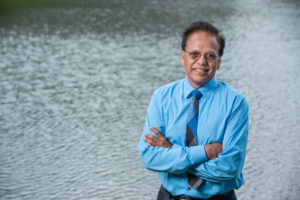By John Burr, Resilient Jax
You’ve probably heard about the plans to build a six-mile, $6 billion wall across Biscayne Bay and downtown Miami to protect the city from a massive hurricane storm surge.
Whatever your thoughts about that, two important points are clear: The wall won’t get built for years to come, if ever, and it won’t get built if the people of Miami don’t want it.
First, a little background: We got to this point following the devastation of hurricanes Katrina and Sandy, when Congress authorized the U.S. Army Corps of Engineers to identify coastal areas particularly vulnerable to hurricanes.
Miami jumped to the top of the list in 2018 because it was already experiencing bouts of climate change-induced flooding, Miami-Dade County’s population of over 2 million people, its flat terrain and Miami’s location smack dab in the middle of Hurricane Alley.

Coming up with the best steps to protect Miami from hurricane storm surge is a long, complicated process. The first phase, a 3-year study scheduled to conclude this fall, will produce a draft report that represents 10% of the work needed to come up with a full flood protection plan.
That full plan from the Army Corps, with local and state input, is still 10 years away, assuming it passes funding hurdles in Congress.
“That means 90 percent (of the plan) is still in front of us,” said James Murley, Miami-Dade’s chief resiliency officer. “90 percent – that means you could never build it, you could end up building something else, or you could build it and supplement it by adding to it.”
So, these are early days in the discussion, or in baseball terms, somewhere in the bottom of the first inning.
Murley and Corps officials agree that there will be many opportunities over the next decade for local officials and agencies to weigh in on the overall plan.
In the final analysis, Miami will have to agree to fund 35% of the multi-billion-dollar cost for the work to start, with the feds paying the rest.
“We obviously would like to have a plan that the community likes,” said Niklas Hallberg, the Army Corps project manager based in Norfolk, Va.
“We’re not going to be building a project without community support.”
A simple way to envision how this could play out is to consider the project recommendation in phases, starting with the simple steps and progressing to the expensive and potentially controversial “structural” projects – the surge wall and a series of movable flood gates that would protect the Miami River and nearby canals from a hurricane storm surge.
Finding the right mix of projects will be key, said Jayantha Obeysekera, a professor at Florida International University. To its credit, he added, the Army Corps has been open to working with others to find that mix.

Obeysekera, director of the university’s Sea Level Solutions Center, favors an approach he calls dynamic adaptive pathways, which, simply put, means starting out by building natural barriers, such as mangrove groves and berms. Such steps, he said, are less invasive and costly, but still offer improved protection from storm surge.
As threats increase over time with sea-level rise and stronger storms, authorities should move on to raising buildings in flood prone areas, and hardening properties such as police and fire stations and hospitals.
If wanted, the higher-level protection of a storm surge wall and canal gates with their massive pump stations can come into play at a later time if the flooding danger rises, as climate scientists predict.
Murley said the natural protections and the elevating of flood prone buildings are likely to move forward. In fact, Miami is already doing some of that, and would certainly continue with the federal government helping to pay.
The big wall and the river gates will be the most controversial. These steps are by far the most expensive parts of the Army Corps proposal, and also offer the most protection to the highest number of people.
“It’s all about risk – how much are you willing to take on,” Murley said. “It comes down to the community’s decision, is this the level of protection we want, given the risk?”

That’s the question that all the coastal Florida cities will face as we move deeper into the 21st century. What can we preserve, but even more difficult, what do we abandon?
And how do we make those decisions fairly for the greatest number of people, and not for the people with money and political connections first and foremost?
Given the fractured and divisive politics we are saddled with today, such dilemmas seem insoluble. Can the true crisis of climate change eventually focus us on the tough choices we face?
Indeed, that may well prove to be the most difficult challenge we have to save the Sunshine State – not how we do it, but can we work together in common accord?
John Burr was a resident expert on the Jacksonville Special Resiliency Committee and is a steering committee member of Resilient Jax.
“The Invading Sea” is the opinion arm of the Florida Climate Reporting Network, a collaborative of news organizations across the state focusing on the threats posed by the warming climate.



